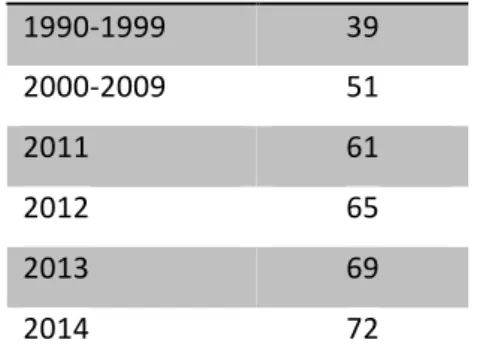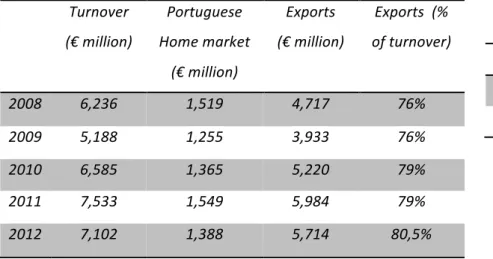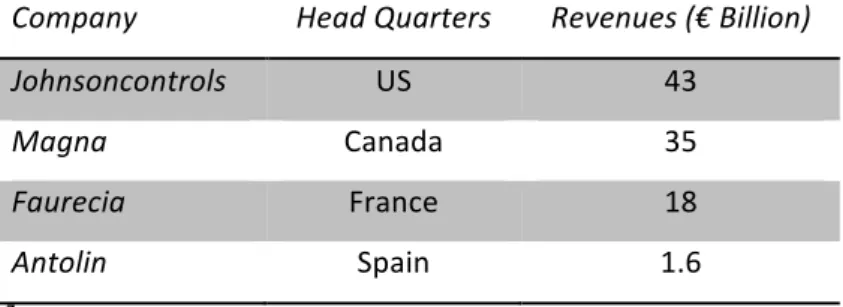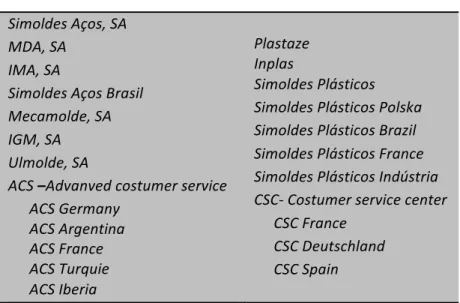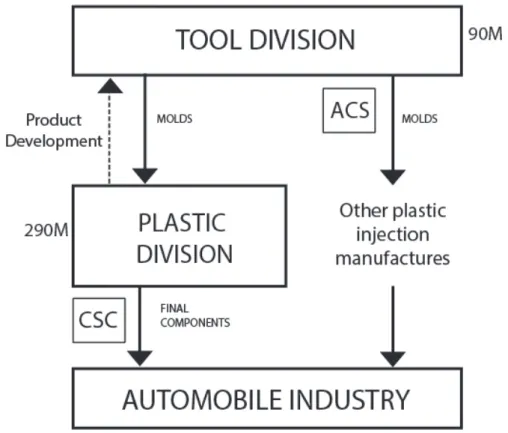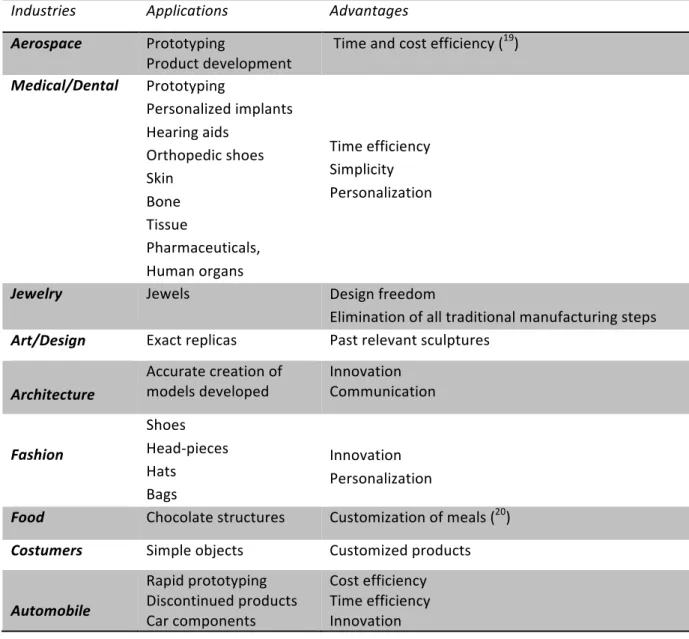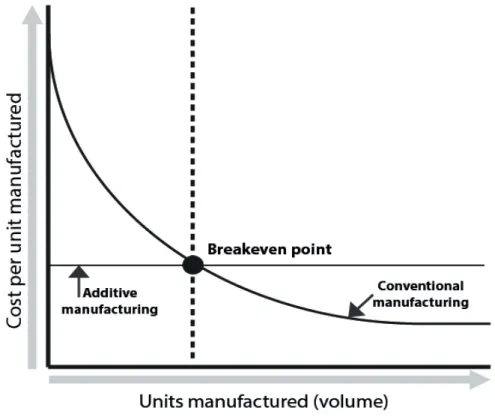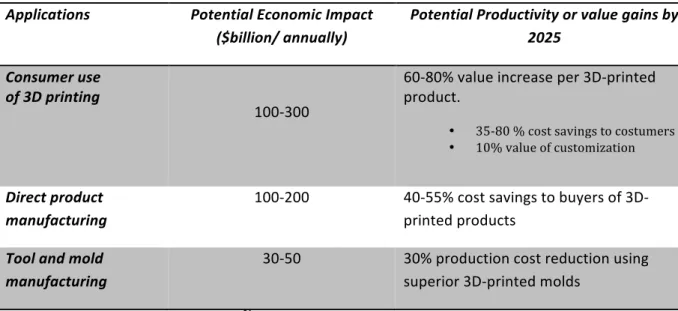SIMOLDES -‐ The Impact of
Additive Manufacturing: 3D
Printing Technology
Ricardo Manuel da Silva Canas
Dissertation submitted in partial fulfillment of requirements for the degree of MSc in Business Administration, at the Católica Lisbon School of Business & Economics, June 2014.
Abstract
Title: SIMOLDES -‐ The Impact of Additive Manufacturing: 3D Printing Technology Author: Ricardo Manuel da Silva Canas.
This case study provides an overview of the automobile industry, Simoldes and the emergence of additive manufacturing technology, also known as 3D printing. The goal of this master’s degree dissertation is to conduct a strategic analysis of Simoldes taking into account the implications of incorporating additive manufacturing technology into the company´s value chain. Understanding what advantages additive manufacturing can bring to Simoldes strategy is fundamental. Different management approaches regarding this technology are provided at the end of the case. Should Simoldes not adopt this technology, or should they proactively incorporate additive manufacturing into its manufacturing process? This is the main subject to the discussed on this master’s dissertation thesis.
In the teaching notes section, there is a set of questions with a proposed resolution. From this analysis, it is possible to see several benefits that additive manufacturing can bring to Simoldes. Efficiencies in time and costs are the main potential advantages. Incorporation of this technology into Simoldes manufacturing processes is the recommended outcome of this case study.
Key words: Innovation, Additive manufacturing, 3D Printing, Simoldes.
Título: SIMOLDES – O Impacto da Fabricação Aditiva : Tecnologia de Impressão 3D Autor: Ricardo Manuel da Silva Canas
Este caso de estudo mostra uma visão geral da indústria automóvel, da empresa Simoldes e do surgimento da tecnologia de fabricação aditiva, também conhecida como a impressão 3D . O objetivo desta dissertação de mestrado é a da realização de uma análise estratégica da empresa Simoldes tendo em conta as implicações da incorporação da tecnologia de fabricação aditiva na sua cadeia de valor. Entender as vantagens que esta tecnologia pode trazer para a Simoldes é um dos aspectos fundamentais. Diferentes abordagens em relação a esta tecnologia são fornecidos no final do caso. Deverá a Simoldes não adotar essa tecnologia , ou deverá incorporar de forma proactiva a fabricação aditiva nos seus processos de produção ? Este é o principal aspecto a ser discutido nesta dissertação de mestrado.
Na secção de notas de ensino , há um conjunto de perguntas com uma proposta de resolução. A partir desta análise , é possível observar vários benefícios que a fabricação aditiva pode trazer para a Simoldes. Ganhos de eficiência no tempo e nos custos são as principais e potenciais vantagens. A incorporação desta tecnologia em processos de fabricação Simoldes é o resultado recomendado deste caso de estudo.
Acknowledgements
I would like to thankfully acknowledge all those who helped me directly or indirectly with the elaboration of this master’s dissertation.
Firstly, I would like to thank my parents, Alfredo and Celinia, for all the support during my academic and personal development. They have provided me with opportunities and advice that have allowed me to reach this academic stage.
This dissertation could not have been developed without the help and information provided by Júlio Grilo, engineering manager at Simoldes Plásticos, and Paula Alexandra, human resource officer. I would like to gratefully thank their availability and help provided. It is also very important to acknowledge Pedro Teixeira, R&D Engineer at the Portuguese company Beeverycreative.
I would also like to thank my friends for all the support provided during this project.
Finally, I deeply thank my thesis advisor João Simão Pires, who provided me with all the help and guidance that I needed. He was responsible for innumerous suggestions and constructive feedback.
Contents
Abstract ... ii
Acknowledgements ... iii
Contents ... iv
List of figures and exhibits: ... vi
CASE STUDY -‐ SIMOLDES -‐ The Impact of Additive Manufacturing: 3D Printing Technology ... 1
1. Introduction ... 1
2. Industry overview and competitive environment ... 1
2.1 Automobile sector overview ... 1
2.2 Auto components sector ... 2
3. Company overview ... 4
3.1 Simoldes Group ... 4
3.2 Linkages between its two key divisions ... 7
3.3 The internationalization process of the Group ... 8
4. Disruptive technology in the market – 3D Printing: Additive Manufacturing (AM) ... 10
4.1 The evolution of 3D printing technology ... 10
4.2 Type of materials used ... 11
4.3. 3D Printing applications ... 13
4.4. 3D Printing impact in manufacturing processes ... 14
5. Simoldes and additive manufacturing ... 18
5.1. Alternatives going forward ... 19
Exhibits: ... 21
TEACHING NOTES ... 24
1. Introduction ... 24
2. Synopsis ... 24
3. Suggested questions ... 25
3.1. Core assignment questions ... 25
3.2. Additional assignment questions ... 25
4. Teaching objectives ... 25
6. Relevant theory ... 26
7. Analysis and case discussion ... 27
8. Conclusion and recommendations ... 43
List of figures and exhibits:
Figure 1 – Number of cars sold worldwide from 1990 to 2014 ... 2
Figure 2 -‐ Recent Auto Component industry evolution in Portugal ... 3
Figure 3 -‐ Simoldes main competitors ... 4
Figure 4 -‐ Simoldes group of companies -‐ 2014 ... 5
Figure 5 – Connections between both divisions ... 7
Figure 6 – Expected growth of 3D printing equipment sales 2012-‐2020 ... 11
Figure 7 – Industry applications and advantages ... 13
Figure 8 -‐ Breakeven analysis: Traditional manufacturing costs vs. 3D printing ... 15
Figure 9 – Potential impact of additive manufacturing by 2025 ... 16
Exhibit 1: Example of a small dimension plastic injection mold ... 21
Exhibit 2: Example of plastic final components manufactured by Simoldes Plastic Division ... 21
Exhibit 3: Example of an industrial 3D printer ... 22
Exhibit 4: Example of the 3D printer of the Portuguese Company Beeverycreative ... 22
Exhibit 5: 3D printing manufacturing companies (Industrial printers) ... 23
CASE STUDY
-‐
SIMOLDES -‐ The Impact of Additive Manufacturing: 3D Printing Technology1. Introduction
In 1984, Charkes W. Hull created the first working 3D printer (three-‐dimensional printing). At that stage, these machines were very expensive and did not have viable commercial applications. Engineers and designers have now being using these machines for more than a decade. Developing quick and cheap prototypes before embarking in expensive manufacturing processes have been the main benefits. Nowadays, due to the latest technology advances, 3D printers have become less expensive and capable of working with a wider range of materials. These devices are already manufacturing final products (1), as
diverse as, car components, jewelry, shoes, pharmaceuticals, and even food.
This case is focused on how advances in three-‐dimensional printing can affect automobile manufacturing industry and its upstream industries. Simoldes, a Portuguese based multinational group will be the focus of this case. How its managers should react regarding these new technology advances will be the main issue to be addressed.
2. Industry overview and competitive environment
2.1 Automobile sector overview
The automobile industry is considered a key sector for all major country in the world. It comprises two different types of manufacturers: the automobile manufacturers and their suppliers. In order to assemble a vehicle, companies use wide variety of materials. These products include components made of steel, iron, aluminum, glass, plastics, textiles, rubber and many others. Estimates state that each direct automobile job creates another five indirect jobs (2), highlighting the importance of the suppliers in this industry.
1 http://www.economist.com/node/18114221
Figure 1 – Number of cars sold worldwide from 1990 to 2014 Million units/Year 1990-‐1999 39 2000-‐2009 51 2011 61 2012 65 2013 69 2014 72 Source: © Statista 2014
Taking into account the statistics and estimations for the number of cars sold, it can be stated that automobile industry is with a growing trend. This fact can also be related with the increased need of cars in developing countries.
Companies like Simoldes depend directly from the number of cars sold. Their growing trend will have a direct impact in this company revenue.
This industry is also one of the largest innovators. In 2012, Volkswagen was the company in the world that invested more in R&D, around 9.5 billion of euros, 5% of their revenues3. This fact reflects an increase interest in new technologies and products that can bring efficiencies to this industry.
2.2 Auto components sector
This sector comprises companies that supply directly or indirectly the automobile industry. The direct suppliers are the ones that sell final components directly to the car manufacturers. The indirect suppliers are the companies that develop the tools, normally molds, which are required by the direct suppliers to make the final component.
The components industry in Portugal tripled in size over the past 15 years. To remain competitive Portuguese companies had to reach rigorous international standards. Simoldes
3http://annualreport2012.volkswagenag.com/managementreport/valueenhancingfactors/researchanddevelop
given the limited size of their home market, focus their sales in international markets. It is the leading Portuguese supplier of molds and components of big car manufacturers, with a turnover around 400 million of euros.
Figure 2 -‐ Recent Auto Component industry evolution in Portugal
Source: AFIA-‐ Associação de Fabricantes de Indústria Automóvel, June 2013
Figure 2 show that the components industry turnover is increasing, exporting 80 % of its output. It is possible to state that exports are the source of growth in this sector. This proves that Portugal is one of the countries chosen to be the supplier of components to the worldwide automobile industry. Highlighting, the importance of companies like Simoldes in the Portuguese Economy.
Portugal is well recognized as mold-‐making and component producer. Some years ago, the rising of China´s economy, with their low-‐income jobs and costs, caused crisis in this Portuguese sector. However, nowadays, big manufacturing car companies returned to Portugal to purchase the required parts (4). The reason behind this development was the price/quality ratio offered by the Portuguese companies. In order to create products with similar quality as in Portuguese companies, the prices in China lose their cost advantage. For this reason, is possible to predict an increase in revenues for European companies in this sector (5).
4 Portuguese association for the mold industry: http://www.cefamol.pt/cefamol/en/Cefamol_IndustriaMoldes
5 Interview with Julio Grilo, engineer at Simoldes Plastic Division Turnover (€ million) Portuguese Home market (€ million) Exports (€ million) Exports (% of turnover) 2008 6,236 1,519 4,717 76% 2009 5,188 1,255 3,933 76% 2010 6,585 1,365 5,220 79% 2011 7,533 1,549 5,984 79% 2012 7,102 1,388 5,714 80,5%
Other Key Figures 2012 Nº Companies 177 Portuguese Owned 49%
There are several auto component companies in Portugal, however, due to the dimension of Simoldes, it is possible to state that in Portugal there is only one company that can be considered as its key direct competitor, Ibermoldes. Their revenues are over 80 million of euros, also selling molds and components to the major car manufacturing companies (6). Therefore, when looking at competition, we have to take into account the major international players (Figure 3).
Figure 3 -‐ Simoldes main competitors
Company Head Quarters Revenues (€ Billion)
Johnsoncontrols US 43
Magna Canada 35
Faurecia France 18
Antolin Spain 1.6
(7) Souce: Simoldes Plásticos
All the companies included in the above table are responsible for only the production of the final component. However, they produce a big range of components, not being specialized only in plastic, as the case of Simoldes components. These firms do not have a division for the production of the molds required. They outsource this part of the process. Being Simoldes Tool division one of the suppliers chosen by these big component companies.
3. Company overview
3.1 Simoldes Group
Simoldes was founded in 1959. It started as a small plant located in Oliveira de Azeméis, in the north of Portugal, and it remains totally owned by a Portuguese family. This company supplies plastic injection molds and also manufactures plastic components, mainly for the
6 A cluster of competences-‐ http://www.afceaportugal.pt/2013/eventos/Grupo_IBEROMOLDES.pdf
automobile industry, which represents 90% of its revenues. Current revenues are in the order of 400 million euros with more than 4,000 employees employed in the firm.
From 1959 till the 1980´s, Simoldes only produced molds for injection companies. In 1981, the group decided to vertically integrate downstream by investing in plastic injection plants. The objective was to supply directly component assemblers developing a direct relationship with this auto car companies.
The group is divided in two different business areas: Simoldes Tool Division and Simoldes Plastic division, which together comprise a total of 16 different companies (Figure 4). At present, the group has manufacturing plants in Portugal, Brazil, France and Poland. Portuguese market only accounts for a symbolic portion of the revenues, 2 million of euros. Therefore, their focus is in international markets. This group has a strong recognition in the automobile industry with brands like Porsche, Toyota, Citroen, Peugeot, Volkswagen, and Skoda listed among its clients.
Figure 4 -‐ Simoldes group of companies -‐ 2014
Simoldes Tool Division
Simoldes Plastic Division
Simoldes Aços, SA MDA, SA
IMA, SA
Simoldes Aços Brasil Mecamolde, SA IGM, SA
Ulmolde, SA
ACS –Advanved costumer service ACS Germany ACS Argentina ACS France ACS Turquie ACS Iberia Plastaze Inplas Simoldes Plásticos Simoldes Plásticos Polska Simoldes Plásticos Brazil Simoldes Plásticos France Simoldes Plásticos Indústria CSC-‐ Costumer service center
CSC France CSC Deutschland CSC Spain Source: http://www.simoldes.com
Simoldes Tool Division
This division of the group is responsible for the manufacturing of injection molds for the plastic components. These molds are a complex set of parts that that when assembled form this type of tool. Their function is to allow the injection of thermoplastic (8) polymers into the mold, where it cools down and hardens in the form of the mold´s cavity. (Exhibit 1) This division is specialized in the production of molds for large plastic components and it exports to more than 30 countries. Revenues in Europe are over 90 million euros. As mold makers Simoldes is the leading group in Europe.
ACS Advanced Costumer Service
In the most important markets, Simoldes Tool division has created local offices where advanced services are available to their major clients. Technicians and engineers mostly compose these departments. The main objective is to provide commercial and technical support to their customers. After sale services, such as, modifications, repairs and maintenance are rapidly provided after the mold arrives to the client.
Simoldes Plastic Division:
Simoldes Plastic division is a group of seven companies. The main stream of revenues comes from this division. Only in Europe, it accounts for over 290 million euros in revenues (9).
These companies are responsible for the injection of the plastic into the mold, producing the final components that are sent to assemblers. (Exhibit 2).
They have a department for the development of the final component, using CAD and special programs (10). Having more than 30 years of expertise, they are able to develop products that make the mold making process easier. These specifications of the final component are then used by the tool division to create the mold required. This department, due to its know
8 Thermoplastic is a polymer which becomes pliable or moldable above a specific temperature and returns to a
solid state upon cooling
9 Interview with Julio Grilo, engineer at Simoldes Plastic Division
10 CAD programs: Computer-‐aided design (CAD) is the use of computer systems as a tool for the creation,
modification, analysis, or optimization of a design. CAD software is used to improve the productivity of the designer, increase quality, and to create a database for manufacturing. The CAD output is normally in the form of electronic file for printing, machining, or other manufacturing operations.
how, is capable of detecting problems and potential efficiencies that are going to be explored in the mold-‐making process. This fact creates one of the major sources of competitive advantages of Simoldes as a group. Companies in Simoldes Tool Division produce 90% of the molds used by this plastic division.
CSC -‐ Costumer Service Center
This department is also distributed across different strategic locations. The goal is to provide assistance to Simoldes Plastic division main costumers namely auto manufacturers. Engineers and technicians constitute these offices where product development and after sales assistance are provided. These special departments work as a complement to the manufacturing facilities of Simoldes Plastics.
3.2 Linkages between its two key divisions
Figure 5 – Connections between both divisions
The differentiation from their main competitors comes from the integration between mold production and the injection of the plastic within the same group. Normally, mold-‐making
companies are small, specialized, and work for a small number of clients. On the other hand, plastic injection companies have a larger dimension. Normally multinational companies that are located closed to their costumers.
The integration between these two divisions in Simoldes group brings several advantages that constitute a source of differentiation versus its competitors. With this integration, Simoldes can guarantee the injection right after the production of the mold. The process reaching the final plastic product is much faster when compared with the normal process. Production of the mold in one company, then moving it to a plastic injection company and finally manufacture of the final component. Having these two divisions, Simoldes can be faster and provide immediate assistance if any adjustment is required in the mold. These specialized tools require constant adjustments in order to reach the final desired component form. Another advantage is that Simoldes can observe directly their own molds functioning in production. This fact allows them to see and study the causes of problems and deformities in the final plastic manufactured good. Most of these problems in the final product occur due to malfunctioning´s of the mold, and the characteristics of the plastic material used. Having product-‐developing teams working along with the mold making division leads to an integration that results in learning economies that are crucial for all the process. As a result of this interaction, Simoldes is able to conceive molds with a superior quality, which results in efficiencies in the injection. Higher final components quality is the positive result of this interaction.
3.3 The internationalization process of the Group
When compared to Portuguese companies in the auto component sector, Simoldes degree of internationalization is very high. The main revenues come from international markets and so a global presence is required in order to continually grow their sales. Currently, and taking into account the two divisions, they have manufacturing facilities in Poland, Brazil, and France. Regarding the costumers service they are present is many other countries, as indicated in the Figure 4.
Normally, when this group decides to enter in a new market they take into account several factors. Being close to their main costumers is one of the most important elements. This fact
allows them to decrease the transportation costs and speed the supply chain. With the “just in time” practices applied in the automobile industry, companies are expecting to receive components in a way that allows them to hold the minimum inventory possible.
Another important fact is the barriers to entry in a given one country. In Brazil, for example, they where obliged to build a manufacturing plant there. The reason behind this fact is the amount of taxes charged on imported products as well as the need to comply with constant local requirements.
The local availability of skilled workforce is also a very important consideration, due to the complexity of the products manufactured, mainly in the Tool division. It is required to have skilled employees with experience and academic training. As a result, low-‐income countries are not the natural targets in this internationalization process.
When Simoldes decides to enter a market, they prefer to start from scratch. Normally, they built their own manufacturing plants rather than purchasing existing companies. They consider that one of their major sources of competitive advantage rests on their manufacturing processes, and so, they build plants in a homogeneous way all over the world. Since they are serving global costumers, product quality has to be the same in the different geographical areas.
Simoldes has plans to continue their internationalization process. Spain, Russia, and the Czech Republic may be the next steps. However, they are dependent on their clients in order to open new facilities in these countries.
Despite of “start from scratch approach”, Simoldes, in countries where the risk of building new facilities is too high, has another form of pursuing its international goals: technical licensing. They have two different licensing types. In the first one, they develop the project, being responsible for the installation of the manufacturing process in given company. Simoldes receives a fee for this service not being accountable for the final manufactured product. On second type, it is a similar process, however, Simoldes receive a royalty for each product produced by that company. The difference is that Simoldes has responsibility over the product and the manufacturing process.
4. Disruptive technology in the market – 3D Printing: Additive Manufacturing
(AM)
“Size is not an issue! It’s budget. You could print an aircraft carrier if you had the budget.” Stated by Jeff Hanson
4.1 The evolution of 3D printing technology
Three-‐dimensional printing or additive manufacturing, consists in developing a three dimensional solid object from a digital file/program. The creation of this object is accomplished using additive processes. This additive process consists in laying down successive layers of an input material until the entire object is created (11).
Three dimension printing technology started being developed in 1980s. Chuck Hull invented a first commercial 3 Dimensional Printer. Through his company 3D Systems, he introduced this technology in the market. This machine used a technique that relied on a laser that solidified an ultraviolet sensitive polymer material everywhere this laser touched (12).
In the industrial world, this technology has been used for decades. Manufacturers used these printers to create prototypes for traditional manufacturing and for research proposes. This process is called rapid prototyping. Nowadays, companies are using this technology for rapid manufacturing, meaning that companies manufacture printed objects that are not prototypes but the actual end user product. This allows companies to create custom made products in a faster and frequently way. Latest developments are enabling companies to create more and more complex products with a wider range of materials (Exhibit 3).
In 2011, personal 3D printing or domestic 3D printing interest started to grow. This fact led to a rapid development of this new market for 3D printers. As a result printers are getting cheaper and more affordable for the general population. Nowadays, smaller 3D printers’ price range is between 250 – 2,500 dollars (Exhibit 4).
11 http://3dprinting.com/what-‐is-‐3d-‐printing/#history
Figure 6 – Expected growth of 3D printing equipment sales 2012-‐2020
Source: Disruptive manufacturing: The effects of 3D Printing, Deloitte
It is expected that sales of 3D printers will quadruple by 2020, highlighting, once again, the importance of this sector in the nearby future.
4.2 Type of materials used
Nowadays, Industrial 3D printers allow companies to print objects with a quality that some years ago would not be possible (13). In parallel, the type of materials that can be used by
these machines has increased. Below, it is described the most common type of materials used by these machines (14): These inputs are used in the form of powder. Plastic and metal
are the types of materials that will be most relevant for this case study.
Plastic
Nylon, or Polyamide, is frequently used. It is a strong, flexible and durable plastic material that showed to be consistent with 3D printing. This can also be combined with Aluminum to produce another common 3D material called Alumide. ABS is another common type plastic used. It is especially strong and is available in an extensive variety of colors. Another plastic material that has been gaining importance is a biodegradable plastic called PLA, however, it is not as durable or flexible has the first two materials.
Metals
An increasing number of metals and metal composites are being used in industrial 3D printing. The most common are aluminum and cobalt derivatives. Another metal that is
13 Interview with Pedro Teixeira, R&D Engineer in the Portuguese company Beeverycreative. A company that is
manufacturing 3D printers.
14 http://3dprintingindustry.com/3d-‐printing-‐basics-‐free-‐beginners-‐guide/materials/
Billion USD
2012 1.3
gaining importance is stainless steel due to his strong structure. Gold and silver have been added to the range of metals that can be printed, with direct applications in the jewelry industry. It is also important to state that titanium, one of the strongest metals known, is now being used as a material to be printed.
Ceramics
This is a new group of materials that is being used by 3D printers. However, it is important to state that after being printed, these ceramic parts will have to go throw the same process as any ceramic part produced in the traditional way. Since it is required to put the piece on the oven in order to cook. Only after this, the final product is created. As result printing final products it´s impossible.
Bio Materials
There is a huge amount of research and interest regarding the use of 3D printers for these types of materials. Living tissue is being investigated with the objective of creating applications for printing human organs or external tissues. For example, it is expected that Organovo, a bio-‐printing company, will reveal the first printed organ in 2014(15).
Food
Printing food experiments have exponentially increased over the last few years. Chocolate is one of the most common materials used. Printers are already capable of working with sugar too. There are also trials with more complex ingredients, pasta and meat. Researchers believe that in the future will be possible to print finalized meals. Anjan Contractor, a mechanical engineer has already developed a machine capable of printing a pizza (16).
15http://www.computerworld.com/s/article/9244884/The_first_3D_printed_organ_a_liver_is_expected_in_20
14
4.3. 3D Printing applications
3D printing technology is being used as an important manufacturing tool by industries/sectors nowadays (17). Highlighting the sectors where the impact of this technology has been higher is important in order to understand the capabilities and functionalities of these machines (18). Once again the Automobile industry will be the most relevant for this case.
Figure 7 – Industry applications and advantages
17 http://3dprintingindustry.com/3d-‐printing-‐basics-‐free-‐beginners-‐guide/applications
18 http://www.techrepublic.com/article/10-‐industries-‐3d-‐printing-‐will-‐disrupt-‐or-‐decimate
Industries Applications Advantages
Aerospace Prototyping
Product development Time and cost efficiency ( 19) Medical/Dental Prototyping Personalized implants Hearing aids Orthopedic shoes Skin Bone Tissue Pharmaceuticals, Human organs Time efficiency Simplicity Personalization
Jewelry Jewels Design freedom
Elimination of all traditional manufacturing steps
Art/Design Exact replicas Past relevant sculptures
Architecture
Accurate creation of
models developed Innovation Communication Fashion Shoes Head-‐pieces Hats Bags Innovation Personalization
Food Chocolate structures Customization of meals (20)
Costumers Simple objects Customized products
Automobile Rapid prototyping Discontinued products Car components Cost efficiency Time efficiency Innovation
4.4. 3D Printing impact in manufacturing processes
Could this new technology “lead the second industrial revolution?” (21) This question is quite relevant due to the capabilities and constant developments in the 3D printing sector.
As stated before, this technology is being revolutionizing the way that manufacturing companies develop new products and technologies. There are several positive impacts that additive manufacturing can bring to enterprises.
Minimum Efficient Scale (22)
The relationship among costs and scale is captured by in the concepts of economies of scale and minimum efficient scale. This represents the scale of operations at which the average cost of each unit of production is minimized. When this minimum is high means that big capital costs are required to start the production.
3D printing is capable of reducing this minimum efficient scale. This technology allows companies to satisfy their need without big expenditures in capital or labor. With these printers the minimum efficiency scale can be potentially achieved at lower unit volumes, meaning that is possible to print one object without the setup costs and tooling required by the traditional manufacturing processes.
19 http://www.thenational.ae/business/industry-‐insights/technology/3d-‐printing-‐is-‐the-‐new-‐dimension-‐for-‐ aerospace-‐industry 20 http://www.livescience.com/40445-‐the-‐ultimate-‐iron-‐chef-‐when-‐3d-‐printers-‐invade-‐the-‐kitchen.html 21 http://www.autoexpress.co.uk/car-‐news/consumer-‐news/64799/3d-‐printing-‐future-‐car-‐industry
22 Cotteleer, M., & Joyce, J. ,2014, 3D opportunity: Additive manufacturing paths to
performance, innovation, and growth. Deloitte Review , Issue 14.
Figure 8 -‐ Breakeven analysis: Traditional manufacturing costs vs. 3D printing
Source: Deloitte University Press
On the graph presented above, it is possible to see a decrease in the average unit cost as a result of an increase in the number of units produced. Traditional manufacturing processes yield cost advantages at higher volumes (economies of scale). When looking at 3D printing, the cost of producing units remains flat, not depending so much on volumes. The intersection between these two lines is the breakeven point, where traditional manufacturing surpasses the cost advantages of 3D printing. However, is expected that this breakeven point will continue to increase in the future as the technology improves.
Scope Economies (23)
This concept is applied to the lowering of the average cost of a firm in producing more than one product; namely as a result of flexibility of a unit of capital. Scope economies present an advantage by producing with the same installed equipment, multiple different products. Traditional manufacturing methods often create limitations in product development due to
23 Cotteleer, M., & Joyce, J. ,2014, 3D opportunity: Additive manufacturing paths to performance,
the high number of parts required to create that final component. Additive manufacturing surpasses all of these problems by creating the final component with a single machine, in one step. A good example of AM capabilities can bee seen in the case of GE new generation aircraft engine. With a printer, GE was able to manufacture the final engine component that
in the traditional manufacturing required the welding of 20 small pieces (24). Flexibility with
decreases in capital costs and increases in innovation.
On the table below its possible to see the potential future economic impact of this technology by 2025:
Figure 9 – Potential impact of additive manufacturing by 2025
Applications Potential Economic Impact
($billion/ annually)
Potential Productivity or value gains by 2025
Consumer use
of 3D printing
100-‐300
60-‐80% value increase per 3D-‐printed product.
• 35-‐80 % cost savings to costumers • 10% value of customization
Direct product manufacturing
100-‐200 40-‐55% cost savings to buyers of 3D-‐ printed products
Tool and mold manufacturing
30-‐50 30% production cost reduction using superior 3D-‐printed molds
Source: McKinsey Global Institute analysis (21)
Consumer use of 3D printing: The potential economic impact is based on the reduced cost printing a product versus buying the item in directly in the retailers, and also the value of customization. It is expected that a 5-‐10% of products like toys, jewelry, and accessories among others, to be printed.
Direct product manufacturing: The potential economic impact comes from printing direct manufactured products with the elimination of tooling, waste, and handling costs (25). Tool and mold manufacturing: This technology has the capacity of reducing setup times, eliminate tooling errors and increase productivity of the injection molding process. McKinsey
stated, “We estimate that 3D printing of tools and molds could generate $30 billion to $50 billion in economic impact per year by 2025, based on an estimated $360 billion cost base for production of injection molded plastics in 2025 and assuming that about 30 to 50 percent of these plastics could be produced with 3D-‐printed molds at around 30 percent less cost.”(25)
If we sum the total potential economic impact of this technology within these three main topics, the value will range from 230 to 550 billion dollars by 2025. It is also important to highlight the potential impact of 3 D printing in the tool and mold-‐manufacturing sector. This fact will impact directly Simoldes, as a plastic injection and mold making company. Another important figure is correlated with cost advantages. It is expected that by using 3D printed molds their cost will suffer a 30 % reduction.
4.5.Impact of 3D printing in the automobile industry
The Automobile industry was one of the first adopters of this technology, using these printers for the fast creation of prototypes. Due to the latest developments, the scope of the usage of this technology has increased. Many companies are realizing the potential benefit of the incorporation of these machines in their manufacturing processes.
There are several examples of companies that are using 3D printers as part of their production and product development process. Bentley Motors, a luxury car company, is printing small-‐scale models and parts for assessment and testing (26). A Swedish manufacturing company called Koenigsegg, responsible for the creation of the model One:1, one of the fastest cars in the world, used 3D printers as a tool from the beginning until the final production of this car. Initially, for the creation of the prototype, and then for manufacturing metal parts for the turbocharger and exhaust system (27). Another important
development was the creation a car called Urbee. This car is cheaper and more fuel-‐efficient
25 Manyika, J., Chui, M., Bughin, J., Dobbs, R., Bisson, P., & Marrs, A., 2013, Disruptive technologies advances
that will transform life, business, and the global economy, McKinsey Global Institute, pp.111
26 http://3dprintingindustry.com/2013/09/15/a-‐peak-‐inside-‐bentley-‐motors-‐with-‐stratasys/
